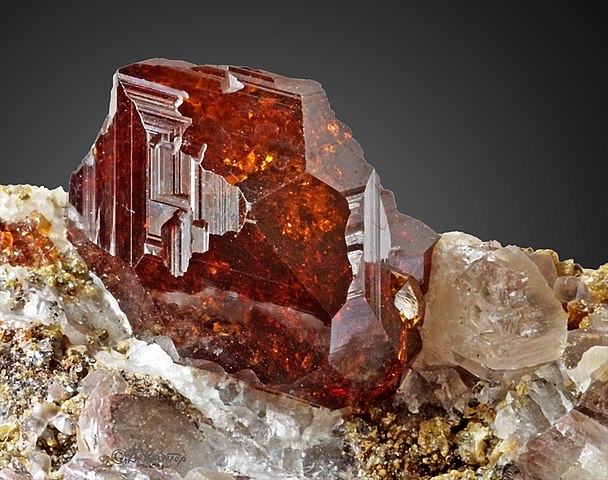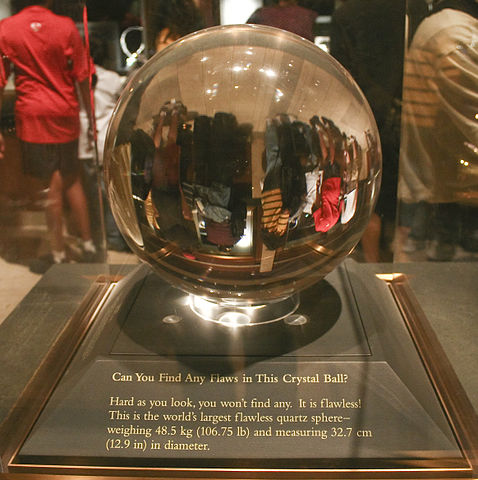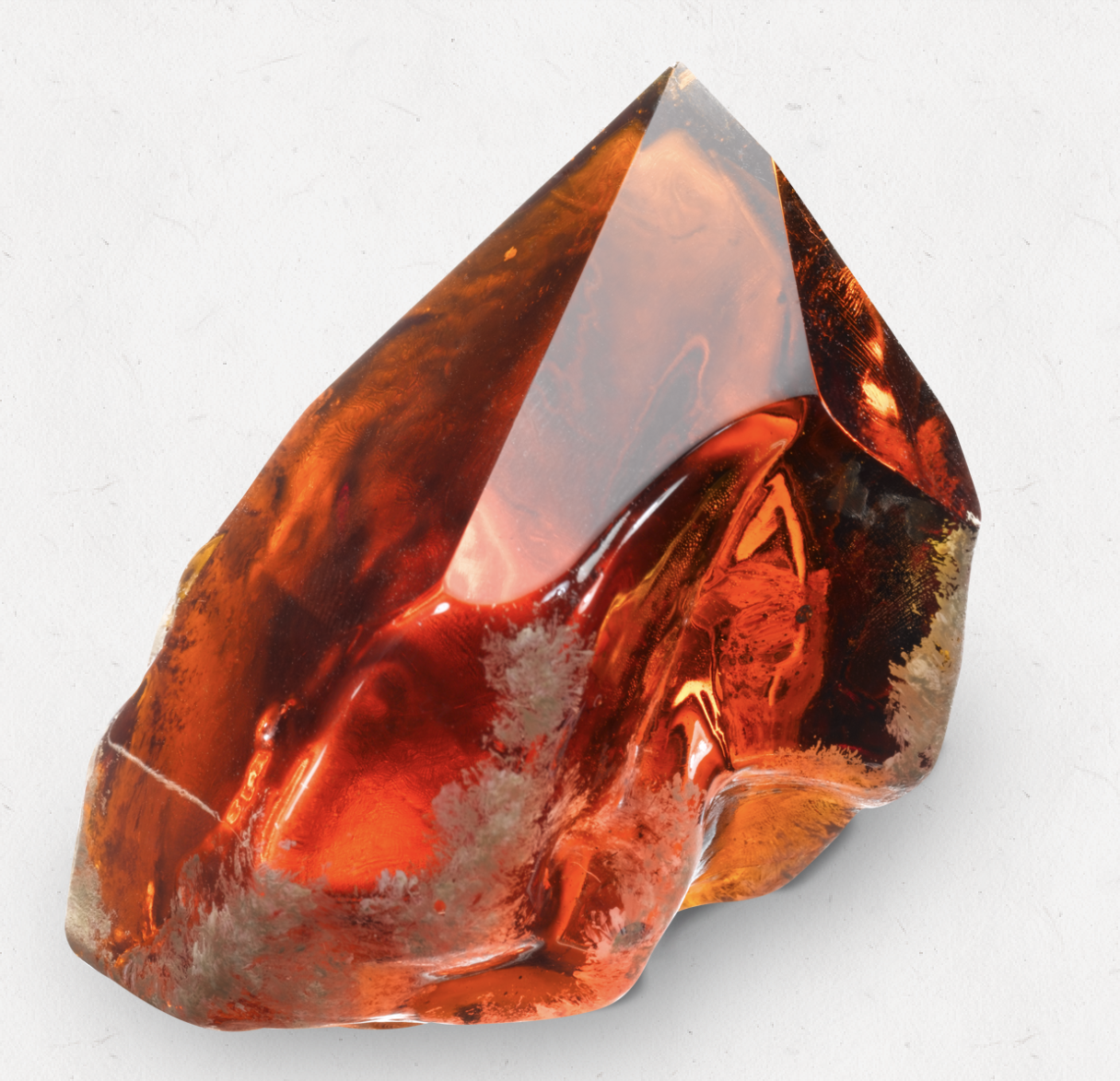Crystal

A crystal or crystalline solid is a solid material whose constituents (such as atoms, molecules, or ions) are arranged in a highly ordered microscopic structure, forming a crystal lattice that extends in all directions. In addition, macroscopic single crystals are usually identifiable by their geometrical shape, consisting of flat faces with specific, characteristic orientations. The scientific study of crystals and crystal formation is known as crystallography. The process of crystal formation via mechanisms of crystal growth is called crystallization or solidification.
Crystals, or crystalline solids, are often used in crystal healing therapy, and, along with gemstones, are sometimes associated with spellwork in Wiccan beliefs and related occult practices. The Sumerians utilized crystals in their magical formulas as long as 6000 years ago.
Examples of large crystals include snowflakes, diamonds, and table salt. Most inorganic solids are not crystals but polycrystals, i.e. many microscopic crystals fused together into a single solid. Polycrystals include most metals, rocks, ceramics, and ice. A third category of solids is amorphous solids, where the atoms have no periodic structure whatsoever. Examples of amorphous solids include glass, wax, and many plastics.
Etymology
The word crystal derives from the Ancient Greek word κρύσταλλος (krustallos), meaning both "ice" and "rock crystal," from κρύος (kruos), "icy cold, frost."
Crystal healing

Crystal healing is an alternative-medicine practice that uses semiprecious stones and crystals with natural healing powers. Practitioners of crystal healing believe they can boost low energy, prevent bad energy, release blocked energy, and transform a body's aura. In one method, the practitioner places crystals on different parts of the body, often corresponding to chakras; or else the practitioner places crystals around the body in an attempt to construct an energy grid, which is purported to surround the client with healing energy.
Crystal healing is heavily associated with the New Age spiritual movement and has become the middle-class New Age healing activity par excellence. In contrast with other forms of complementary and alternative medicine (CAM), participants in crystal healing view the practice as "individuated," that is dependent on extreme personalization and creative expression.
Practitioners of crystal healing purport that certain physical properties such as shape, color, and markings, determine the ailments that a stone can heal; lists of such links are published online and in crystal healing books. Paradoxically, practitioners also "hold the view that crystals have no intrinsic qualities but that, instead, their quality changes according to both" participants. After selecting the stones by color or their believed metaphysical qualities, they place them on parts of the body. Color selection and placement of stones are done according to concepts of grounding, chakras, or energy grids.
Varying beliefs
Across cultures, different stones can symbolize or provide aid for different things. An example of this is rose quartz:
- Ancient Egypt: rose quartz prevents aging.
- Ancient Rome: used rose quartz as a seal to signify ownership.
- Medieval Europe: rose quartz was used in healing potions
- Modern view: rose quartz is known as the "love stone."
Egyptian beliefs
Ancient Egyptians mined for crystals and used them to make jewelry. Crystals or gemstones were also used in ritual magic for their metaphysical properties. Specifically, they used crystals as aids for health and protection. They often would bury a lapis lazuli scarab with their deceased, with the belief that it would protect them in the afterlife.
Additionally, in Ancient Egypt amulets were used to ensure the well-being of the individual. The amulet's shape, decoration, inscription, color, material, or ritual performed with the amulet dictated its power. Amulets were worn or placed on the body, in the form of stones, piercings, rings, necklaces, or other jewelry. The Egyptians used amulets to benefit their afterlife, often representing an Egyptian deity and their specific powers. Amulets were also placed on mummies or in between the mummy's bandages, with funerary pieces usually being larger than those worn by the living.
Each of the Egyptian decans was associated with a mineral, and in some cases, specific crystals. These minerals were utilized to facilitate a connection with the decanal gods, although the exact mechanism and significance of this connection is not yet known.
Greek beliefs
In Plato's account of Atlantis, crystal healing is also mentioned. According to Plato, the Atlanteans used crystals to read minds and transmit thoughts.
The Ancient Greeks assigned a multitude of properties to crystals. They believed that clear quartz crystals were a water that had frozen to the point where it would remain in its solid form. The word "amethyst" in Ancient Greek language means "not intoxicate." Amethyst was worn as an amulet that they believed would aid hangovers or prevent intoxication.
Medieval European beliefs
Both Pliny the Elder and Galen claimed that certain crystals had medicinal properties. In Europe, the belief in the healing powers of crystals (and in particular crystal amulets) persisted into the Middle Ages. The medicinal properties of precious stones, as well as other powers they were believed to hold, were collected in texts known as lapidaries, which remained popular in Medieval and Early Modern Europe until the 17th century.
Some grimoires on ritual magic describe a process whereby an exorcist may trap a demon inside a crystal.
Use in divination
Crystals are utilized by modern psychics and others as a tool to facilitate divination. Perhaps the most common usage is in scrying, the practice of looking into a reflective surface in the hope of detecting significant messages or visions. Specifically-shaped crystals, such as a crystal ball, are frequently employed and have entered popular culture as tropes in fiction.
Functions of some specific crystals
- Amethyst: remove negative energies and drive away the hazards of daily life (Feng Shui).
- Beryl: used to fight against demons from the fourth order in the Hierarchy of Hell.
- Diamond: bring healing to the mind and heart while eliminating negative energy (Hinduism).
- Emerald: cause venomous animals to become blinded (alchemy).
- Quartz: manifesting healing, enhancing meditation, providing protection, and facilitating channeling.
Magical crystal artifacts
Some crystal artifacts which are said to contain magical powers include:
- Cup of Jamshid
- Crystal balls
- The Philosopher's stone
- The Emerald Tablet
- Crystal skulls
Commercial trade
Worldwide, retail sales of crystals were estimated to amount to more than US$1 billion per year in 2019. Where the practice of crystal healing is popular, it fosters commercial demand for crystals, which can result in environmental damage and exploitative child labor to mine the crystals.
India, China, Brazil, and Madagascar are the main producers of crystals. In Madagascar, one major source of crystals, most crystals are mined in unsafe, non-industrial or "homemade" mines, with parents and children working together to dig crystals from pits and tunnels they dig with shovels.
The miners are usually paid between 17 and 23 cents per kilogram for rose quartz (less than a penny per ounce). The miner's income may be just 0.1% of the final retail price. Some people in the industry say that the low pay for miners is because customers in developed countries want low retail prices; others say that it is due to shops in developed countries wanting to be more profitable.
